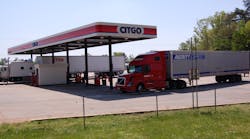Average retail pump prices in the U.S. for diesel and gasoline took a welcome albeit small dip this week, according to data tracked by the Energy Information Administration (EIA).
Diesel dropped 6/10ths of a penny to a U.S. average retail pump price of $3.909 per gallon, with prices dropping in all but three regions of the country, EIA noted. However, the agency pointed out that diesel costs 5.9 cents per gallon more this week compared to the same week in 2012.
The three regions that experienced a diesel price hike were: the Rocky Mountains, where diesel spiked 1.8 cents to $3.931 per gallon; the West Coast, where prices climbed 2/10ths of a penny to $4.054 per gallon; and California, which witnessed a 1.1 cent diesel increase to $4.133 per gallon.
Currently, EIA said diesel exceeds the $4 per gallon mark in three regions of the U.S.: the West Coast, California, and New England ($4.056).
Meanwhile, prices for diesel exhaust fluid (DEF) remain relatively stable, with tote refill prices dropping one cent to $1.96 per gallon in the U.S. during July versus June, according to Integer Research, while the average tote refill price for DEF increased two cents in Canada to CA 59 cents per liter (roughly US$2.27 per gallon) compared with June.
Integer added that DEF truck stop prices also remained stable in the U.S. at $2.79 per gallon in July – the same price point since November 2012 – while holding at CAD$ 0.80 per liter (some US$3.08 per gallon) in Canada since October 2011.
The group noted that Phoenix, AZ, and Los Angeles, CA, posted the highest average prices for 2.5 gallon jugs in the U.S. while Atlanta, GA and Portland, OR registered the lowest average prices for 2.5 gallon jugs amongst all areas covered by Integer.
Back on the fuel front, EIA said U.S. average retail pump prices for gasoline dropped 1.4 cents to $3.632 per gallon, with gasoline now 1.3 cents per gallon cheaper this week compared to the same time period in 2012.
EIA also pointed out that gasoline prices fell in every region of the country except the Midwest, where retail pump prices climbed 1.4 cents to $3.589 per gallon.
The agency stressed, however, that average regular retail gasoline prices in 2013 to date remain about 5 cents per gallon lower, down some 1%, compared to the average price for the fuel over the same period last year, with crude oil prices and refinery availabilities the main driver behind pricing trends.
Along the East Coast (PADD 1) EIA said average gasoline prices were down 7 cents per gallon during the first half of 2013 compared to the same period in 2012, but as of July 29 they were 15 cents above their year-ago level. However, 2013 average prices through July were 5 cents below the same period a year ago.
By contrast the Midwest (PADD 2) is experiencing more price volatility this year. While gasoline prices were 6 cents above their year-ago level as of July 29, average year-to-date gasoline prices through July 29 were the same as in 2012. Planned and unplanned refinery maintenance as well as longer-term refinery upgrading projects over the past few months reduced gasoline production in the Midwest, drawing down gasoline inventories and pushing gasoline prices higher, the agency noted.
As a result, Midwest daily average retail prices have fluctuated widely during 2013, EIA said, noting that on a state-level basis, prices were even more volatile as several states experienced big gasoline price ranges including Minnesota, North Dakota, and Michigan.
Along the Gulf Coast (PADD 3), though,average year-to-date U.S. Gulf Coast gasoline prices in 2013 are about 6 cents per gallon below their 2012 level, the agency pointed out, chiefly reflecting lower prices for the Light Louisiana Sweet (LLS) crude oil. However, as of July 15, PADD 3 gasoline prices had risen 15 cents from the previous week, up 24 cents per gallon compared to the same time a year ago.
By July 29, prices rose to average $3.48 per gallon in the Gulf Coast region, 17 cents above the same week in 2012, said EIA. Yet those recent increase in prices, compared to other regions, gasoline prices in PADD 3 have been relatively stable in 2013 – stability that occurred despite higher growth in gasoline demand than in other regions.
Gasoline pricing is fluctuating more widely in the Rocky Mountain (PADD 4) region, with prices so far in 2013 reflecting a wide range in PADD 4 because of the low price at the start of the year and the spillover effects from PADD 2 refinery maintenance. As of July 29, PADD 4 gasoline prices were 17 cents per gallon higher than a year ago, but the year-to-date 2013 average price remains 42 cents below the same period of 2012, EIA noted.
Finally, along the West Coast (PADD 5), while retail gasoline prices are 22 cents per gallon higher compared to the same time in 2012, they are 9 cents per gallon on average lower year-to-date compared to 2012 – the largest decline of any region, according to EIA’s numbers.
Refinery maintenance resulted in several sharp increases in wholesale gasoline prices in PADD 5 during the first half of 2013, the agency said, but only one increase beginning in January significantly affected retail prices. Also, because of a combination of stringent environmental requirements and taxes, West Coast retail gasoline prices are generally the highest in the Lower 48 states, EIA stressed.



